Holothuriida
Holothuriida is an order of sea cucumbers.[1] Taxa within the order Holothuriida were previously classified in the order Aspidochirotida, which was determined to be polyphyletic in 2017. Some taxa were also reclassified into the clades Synallactida and Persiculida.[2]
| Holothuriida | |
|---|---|
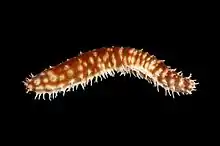 | |
| Holothuria hilla | |
| Scientific classification | |
| Domain: | Eukaryota |
| Kingdom: | Animalia |
| Phylum: | Echinodermata |
| Class: | Holothuroidea |
| Order: | Holothuriida Miller, Kerr, Paulay, Reich, Wilson, Carvajal & Rouse, 2017 |
| Families | |
| |
Description and characteristics
Species of the order Holothuriida are distinguished from other sea cucumbers by the presence of flattened, often leaf-like tentacles, but without the other large appendages found in the related order Elasipodida. They do not have introvert or retractor muscles.[3] The tube feet often form a clearly demarcated sole. They have 15-30 shield-shaped retractile tentacles surrounding their mouths. The body wall is thick and leathery and contains ossicles, including some table-shaped ones. They have respiratory trees for gas exchange. The mesentery of the posterior loop of their gut is attached to the right ventral interradius. The muscles that run longitudinally down the body are arranged into five double bands. They can emit sticky white threads known as cuvierian tubules from their cloacas in order to distract or entangle predators. They are usually found in exposed shallow-water environments.[4]
Conservation status
Their popularity as luxury seafood in some Asian countries poses a serious threat to the order.[5]
List of families
- Holothuriidae Burmeister, 1837 – 5 genera
- Mesothuriidae Smirnov, 2012 – 2 genera

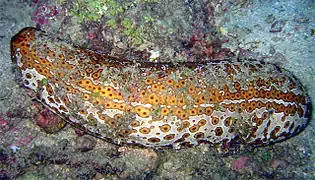
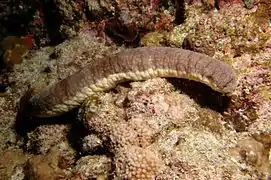
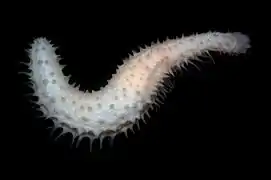
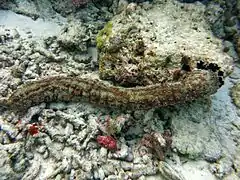
 Mesothuria sp.
Mesothuria sp.
References
- Paulay, Gustav (2017). "Holothuriida". WoRMS. World Register of Marine Species. Retrieved 2017-11-29.
- Paulay, Gustav (2017). "Aspidochirotida". WoRMS. World Register of Marine Species. Retrieved 2017-11-29.
- An illustrated key to the sea cucumbers of the South Atlantic Bight Retrieved 2012-02-12.
- Order Aspidochirotida Marine Species Identification Portal. Retrieved 2012-02-10.
- Steven W. Purcell; Beth A. Polidoro; Jean-François Hamel; Ruth U. Gamboa; Annie Mercier (5 March 2014). "The cost of being valuable: predictors of extinction risk in marine invertebrates exploited as luxury seafood". Proceedings of the Royal Society B: Biological Sciences. 281 (1781): 20133296. doi:10.1098/rspb.2013.3296. PMC 3953849. PMID 24598425.